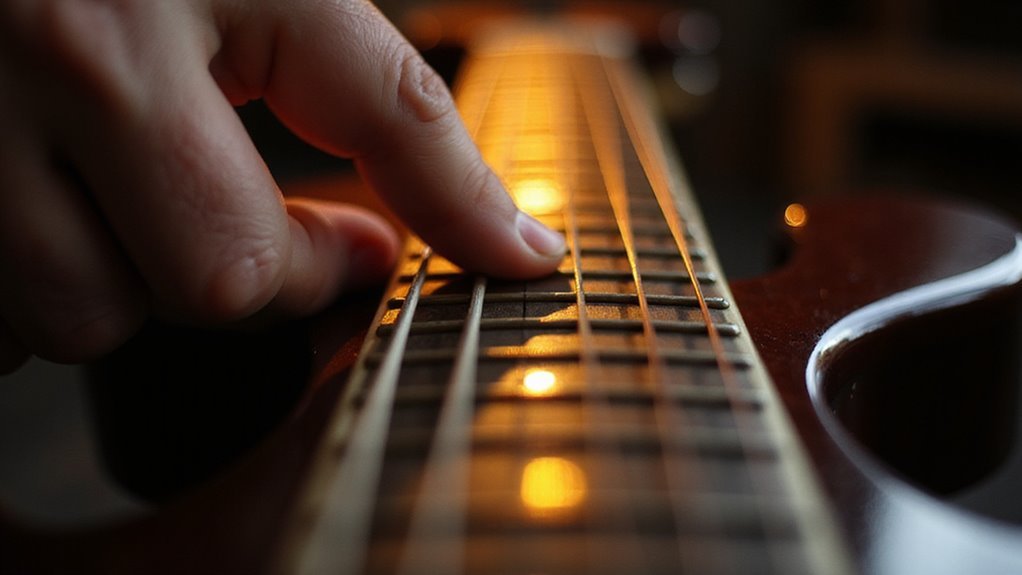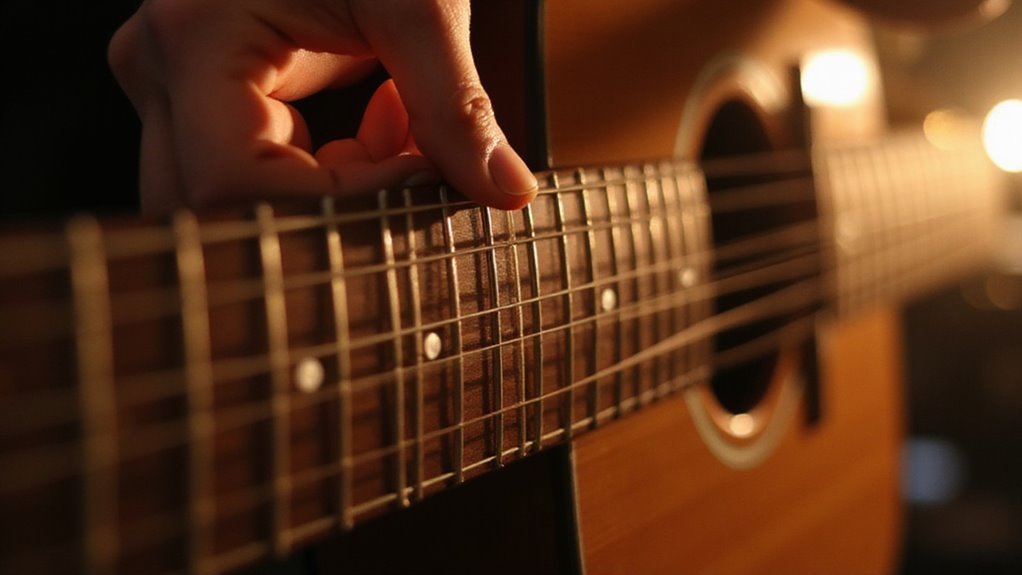Have you ever heard that angelic, bell-like sound floating above a guitar melody? That’s the magic of harmonics – and they’re not as mysterious as you might think. You’ll discover that with a light touch at specific points along the string, you can coax out these ethereal tones that’ll transform your playing. I’ve found that mastering harmonics requires some patience, but once you get the technique down, you’ll open up a whole new dimension to your musical expression. Let’s uncover how it works.
Understanding the Magic Behind Guitar Harmonics

Harmonics – those ethereal, bell-like tones that seem to float above your guitar’s regular sound. They’re almost magical when you first hear them, aren’t they? Many guitarists feel intimidated by harmonics, thinking they require some special gift to master.
The truth is, harmonics are simply physics in action. When you lightly touch specific points on the string—particularly at the 5th, 7th, and 12th frets—you’re actually isolating natural vibration points.
I think what makes harmonics feel so special is that they connect us to something ancient in music, perhaps something we instinctively recognize but can’t quite name.
Essential Tools and Gear for Perfect Harmonic Tones

Three essential tools can make all the difference when you’re trying to create crystal-clear harmonics on your guitar.
I think most players overlook these basics, focusing too much on technique alone.
- A quality guitar with proper intonation (cheaper instruments might struggle with harmonics)
- Light-gauge strings that vibrate more freely
- A compressor pedal to enhance sustain and clarity
Your amplifier settings matter too.
Perhaps try rolling back the bass slightly while boosting the mids—this helps harmonics cut through.
Mastering the Fundamental Techniques of Natural Harmonics

When you first attempt natural harmonics on guitar, the ethereal bell-like tones can seem almost magical. But trust me, you’ll be creating these beautiful sounds with practice and proper technique. It’s all about where and how you touch those strings.
| Harmonic Node | Sound Produced | Difficulty | Common Use |
|---|---|---|---|
| 12th Fret | One octave up | Easiest | Intros, solos |
| 7th Fret | Octave + fifth | Moderate | Folk, ambient |
| 5th Fret | Two octaves up | Moderate | Classical, rock |
| 3rd/4th Fret | Higher harmonics | Challenging | Advanced solos |
Advanced Methods for Creating Artificial Harmonics
Unlike their natural counterparts, artificial harmonics open up a whole new dimension of sonic possibilities on your guitar. I think mastering this technique might take more practice, but it’s totally worth the effort.
You’ll need to lightly touch the string at specific nodes (usually 5th, 7th, or 12th fret) with your index finger while picking with your thumb or another finger.
- Remove your finger immediately after picking to let that beautiful harmonic ring out
- Experiment with different amplifier settings to find your unique harmonic voice
- Practice daily, perhaps just 10 minutes, focusing on consistent technique rather than speed
Common Mistakes to Avoid When Playing Harmonics
Many guitarists struggle with harmonics despite their seemingly simple nature, often because they’re making fundamental mistakes that prevent those ethereal tones from ringing true. I think the most common issue is pressing too hard at the node—you’re just looking for a light touch, not fretting the note.
| Mistake | Solution |
|---|---|
| Pressing too hard on node | Touch string lightly, then release |
| Poor node location | Aim precisely at 5th, 7th, or 12th fret |
| Slow finger removal | Release immediately after picking |
| Out-of-tune guitar | Always tune properly before attempting |
| Inconsistent picking | Maintain steady, deliberate technique |
Perhaps try recording yourself to identify where your technique needs work. Patience is key!
Incorporating Harmonics Into Your Musical Compositions
Harmonics aren’t just technical exercises—they’re powerful tools that can elevate your musical compositions from ordinary to extraordinary.
When you’re arranging a piece, consider where harmonics might create that ethereal quality that draws listeners in. I think they work particularly well as accent notes or to highlight key moments in your progressions.
- Use harmonics as passages between sections to create breathing room
- Combine natural and artificial harmonics for textural contrast
- Layer harmonics with regular notes for a shimmering, complex sound
Frequently Asked Questions
Can Harmonics Damage My Guitar Strings Over Time?
No, properly executed harmonics won’t damage your strings. They’re just a different playing technique. You’re simply touching the string at specific nodes rather than pressing down harshly.
How Do Guitar Harmonics Differ Across Various Musical Genres?
Gorgeous genres gracefully guide your harmonic journey. You’ll hear bright, chiming harmonics in rock, delicate natural harmonics in classical, and screaming artificial harmonics in metal. We all experiment with these techniques differently.
Are Harmonics Easier to Produce on Acoustic or Electric Guitars?
You’ll find harmonics easier on electric guitars due to their lower action and amplification. But with practice, you can achieve beautiful harmonics on both types with the right technique.
Can Left-Handed Guitarists Use the Same Harmonic Techniques?
Like a mirror reflection of their right-handed peers, you’ll find harmonic techniques work identically for left-handed guitarists. You’ll touch the same nodes with your right hand while picking with your left—same magic, different hands.
Do Temperature and Humidity Affect the Quality of Harmonics?
Yes, temperature and humidity directly impact your harmonics. High humidity can dampen resonance while extreme temperatures affect string tension. You’ll notice clearer harmonics in stable, moderate conditions.
Conclusion
You’ve now glimpsed the ethereal world of guitar harmonics, but the journey doesn’t end here. Like diamonds hidden in coal, these techniques require your patience and practice to truly shine. Whether you’re adding sparkle to a solo or depth to your compositions, harmonics will transform your playing from ordinary to extraordinary. So pick up your guitar, find those sweet spots, and let your harmonics ring true.